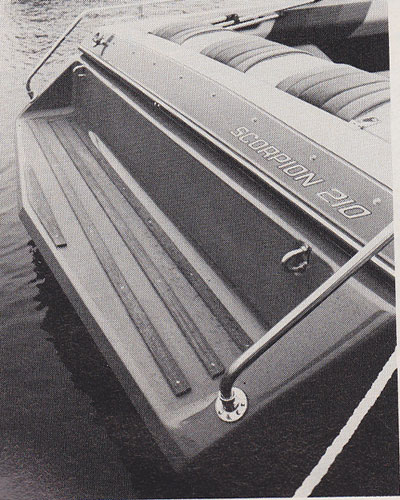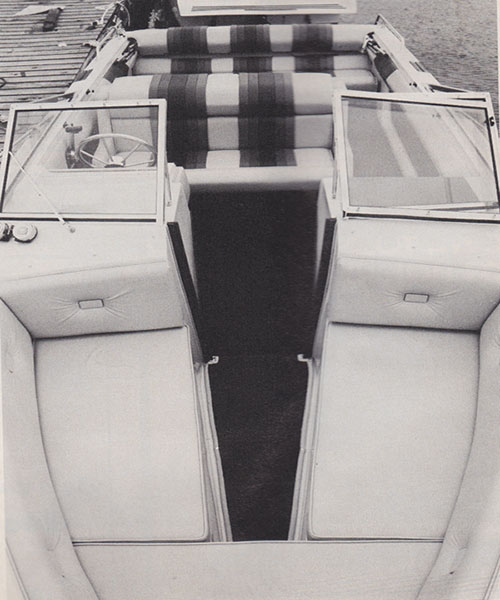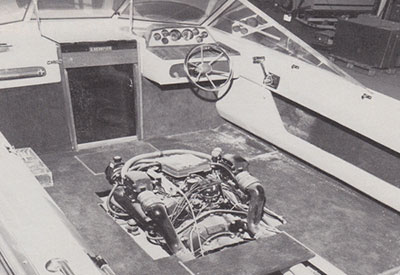Scorpion 210F
A quick to plane day boat at home in cottage country.
By Doug Dawson
The Chris-Craft Scorpion 210F is a sport boat with a unique combination of a midship motor and an outdrive on the transom. Offering the choice of bow rider or cuddy cabin versions, the Scorpion is built by ACF Grew in Penetang, Ontario, under a licensing agreement for selected ChrisCraft models in Canada. The Scorpion 210F’s engine block is installed in the middle of its hull, as in a vintage mahogany launch. This transfers the engine weight forward, making the boat quick to plane and able to stay on a plane at much lower speeds than normal. The outdrive is still secured to the transom, as it is in all sterndrive boats, offering boaters the familiar maneuvering advantages of an outdrive, including power trim and power steering.
Another advantage of the engine location is that it opens up the aft section of the cockpit-it no longer contains an engine block around which the designer has to build a box. You may be wondering, since ChrisCraft has its motor in the middle and its drive on the transom, how power gets from one to the other. T his is accomplished by a long drive shaft similar to that in a car with rear-wheel drive. The Scorpion is the only pleasure boat I know of that accommodates the Mercruiser Extended Shaft. During sea trials on Georgian Bay, I found the Scorpion bow rider easy to handle. When idling, the boat followed a straight course, avoiding the snaking wake of many other deep-V hull boats.
At 2,300 rpm with one person onboard and half a tank of fuel, the 210F planed easily, without trim tabs. At 2,800 rpm the Scorpion was extremely smooth, maneuverable and responsive. At 3,000 rpm, the boat moved out very quickly and handled hard-over to hard-over figure eights without falling off a plane or cavitating. Mercruiser’s test evaluation center measures the engine’s top speed at 4,700 rpm to be 45.8 mph. Even though the helm seat is located above the engine, I was surprised how quiet the boat was. This was due, of course, to heavy insulation on the outside.
 The scorpion 201F would be a perfect ski boat because its wake is very small, thus making wake crossing simple. Further, its ability to move swiftly onto a plane would get the skier out of the water quickly. On the day I tested the boat Georgian Bay was quite calm, so we had the photo boat plow up some wakes to jump. Because the boat was so maneuverable and responsive I enjoyed doing more than the usual number of wake jumps. No matter how fast or at what angle I hit the waves, the Smrpion always landed smoothly. It’s a fun boat to drive. An integrated swim platform is quite different in construction from the teak platforms that most of us are used to.
The scorpion 201F would be a perfect ski boat because its wake is very small, thus making wake crossing simple. Further, its ability to move swiftly onto a plane would get the skier out of the water quickly. On the day I tested the boat Georgian Bay was quite calm, so we had the photo boat plow up some wakes to jump. Because the boat was so maneuverable and responsive I enjoyed doing more than the usual number of wake jumps. No matter how fast or at what angle I hit the waves, the Smrpion always landed smoothly. It’s a fun boat to drive. An integrated swim platform is quite different in construction from the teak platforms that most of us are used to.
Fiberglass side panels support the platform instead of teak legs that push it up from underneath. Apart from the appealing style of these side panels, they allow the deck of the platform to be closer to the water, making boarding from the lake easier. The platform has three teak nonskid strips. The two aft mckpit rails are extended over the transom and down to the platform as handholds. Let’s step forward over the swim platform, past the transom and onto the back seat. With no motor to widen the aft deck, the distance from the platform to the back seat is decidedly shorter and easier to traverse.
This full-width lounge offers comfortable seating for four adults, with thick foam and folded layers of vinyl upholstery. The lounge converts to a comfortable sunning area when the bottom of the seat is pulled forward and the backrest dropped down. With the backrest down, you would expect to see the hull under the aft deck, but you don’t. A snap-in vinyl drape covers this opening, hiding access to the battery and power trim pump, blower motors and the like. Under the aft seat bottom is the 57 –gallon stainless steel fuel tank. The upper half of the backrest folds up and aft to reveal a hidden storage spot for the convertible top.
There is also enough room in here for stowage the side and aft curtains. The cockpit has a durable carpet glued in place, striped bolsters on the sides and padded panels that run its full length. The carpeting and padding absorb sound to create a quiet boat. In the middle of the cockpit is a lounge wide enough to seat three people facing forward and three more facing aft. The aft section of the cockpit, with the two lounges facing each other, forms a comfortable conversation area for seven adults. Lift this center lounge and you’ll find the motor. Attached to the back of the motor, instead of a transmission or sterndrive, is the long drive shaft, which extends all the way under the cockpit floor and the stem lounge to the outdrive. Flanking the drive shaft are two fiberglass exhaust pipes that connect the motor to the outdrive exhaust ports.
 The entire inside of the lounge’s wooden frame is covered with sound-deadening foam insulation. The outside is covered with carpet on the lower section and padded upholstery on the top. If you were blindfolded and taken to a seat on this lounge, you would never know that you were sitting over the motor-at any speed. The helm, located on the starboard side, is a molded fiberglass section of the deck. The instrument panel is complete with tachometer, oil, temperature, voltage, fuel and trim gauges. Accessory switches and their fuses are mounted to the starboard side of the wheel. The bevels around the gauges, like the wheel, are in stainless steel. The throttle-shift lever is mounted so the helmsman’s right elbow rests on a padded bolster. In the port corner of the cockpit, opposite the helm, is a thoughtfully designed, molded fiberglass compartment.
The entire inside of the lounge’s wooden frame is covered with sound-deadening foam insulation. The outside is covered with carpet on the lower section and padded upholstery on the top. If you were blindfolded and taken to a seat on this lounge, you would never know that you were sitting over the motor-at any speed. The helm, located on the starboard side, is a molded fiberglass section of the deck. The instrument panel is complete with tachometer, oil, temperature, voltage, fuel and trim gauges. Accessory switches and their fuses are mounted to the starboard side of the wheel. The bevels around the gauges, like the wheel, are in stainless steel. The throttle-shift lever is mounted so the helmsman’s right elbow rests on a padded bolster. In the port corner of the cockpit, opposite the helm, is a thoughtfully designed, molded fiberglass compartment.
The lid lifts up to reveal a deep glove box for sunglasses, suntan lotion and such. The lid is held in place with a Velcro fastener. Down in the bottom of this compartment is a drain hole-just in case someone leaves the lid open and rainwater gets in. On the vertical surface is a short handrail. The windshield is raked back to add to the streamlined appearance of the boat. If you stand facing forward with your elbows on top of the windshield frame, you have two accommodation choices for the rest of the boat before you- bow rider or cuddy cabin. As a bow rider, the Scorpion’s windshield hinges open and a black Plexiglas panel door below the windshield slides open. If you step forward, you will enter an area offering seating for an additional four people-six if you squeeze them in. The padded seats and backrest are comfortable, and the high bowrail gives you a reassuring handhold. Storage for life jackets, ski belts and ski ropes is offered under the seat bottoms.
A tonneau cover protects the bow area from the weather when not in use. The bow rider version is new for 1985-kids love bow riders. Back up and put your elbows on the windshield top again. Ahead of you in the cuddy cabin version is a fiberglass deck with a large, black Plexiglas deck hatch. Your legs are resting against the cuddy cabin door. The companionway to the cabin opens when you slide the small, black Plexiglas door to your left and lift the curved black Plexiglas and teak companionway hatch up against the windshield.
The V berth fills the entire cuddy cabin area, with carpeting on the floor, hull sides and underside of the deck. Light and air enter from the deck hatch. Two portlights allow you to peek out the sides. The cabin is large enough for an afternoon snooze or occasional overnight trip, but is not intended for extended cruises. Because of the low profile of the hull, there is no space below the V-berth cushions, accommodate a head-not even the smallest toilet on the market. This boat is intended to be a big cottage boat as opposed to a small cruiser. If a big cottage boat is what you’re after, have a look – the Chris-Craft Scorpion 210F.
Doug Dawson owns Doug Dawson Yacht sales. He is an experienced member of the marine industry and a past president of the Ontario Marina Operators Association.
Originally published in Canadian Yachting’s February 1985 issue.
 Specifications:
Specifications:
Centerline Length………….20ft 7in
Beam…………………………….8ft
Cockpit length……………….11ft
Height……………………………5ft 10in
(Keel to top of windshield)
Weight: Cuddy………………..3,614lbs
Bow Rider…………..3,674lbs
Fuel………………………………….57 gal
Engine ………………………….Mecruiser 260-hp Extended Shaft
List Price: Cuddy……………….$33,000
Bow Rider………….$33,400























